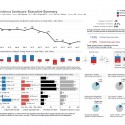Applying Clustering to Streamline Data Analysis
The practical applications of clustering are vast. With the ability to identify groups in the data based on their shared characteristics, future customers, employees and stakeholders can be marketed and delivered products and services that are most likely to be pertinent to their specific needs.









